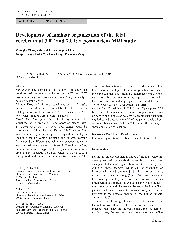摘要
The purpose of this study is to show the condition of laminar organization on 3.0T and 7.0T postmortem magnetic resonance imaging (MRI) and analyze developmental changes.
Heads of 131 fetal specimens of 14-40 weeks gestational age (GA) were scanned by 3.0T MRI. Eleven fetal specimens of 14-27 weeks GA were scanned by 7.0T MRI. Clear images were chosen for analysis.
On T(1)-weighted 3.0T MRI, layers could be visualized at 14 weeks GA and appeared clearer after 18 weeks GA. On 7.0T MRI, four zones could be recognized at 14 weeks GA. During 15-22 weeks GA, when laminar organization appeared typical, seven layers including the periventricular zone and external capsule fibers could be differentiated, which corresponded to seven zones in histological stained sections. At 23-28 weeks GA, laminar organization appeared less typical, and borderlines among them appeared obscured. After 30 weeks GA, it disappeared and turned into mature-like structures. The developing lamination appeared the most distinguishable at the parieto-occipital part of brain and peripheral regions of the hippocampus. The migrating thalamocortical afferents were probably delineated as a high signal layer located at the lower, middle, and upper part of the subplate zone at 16-28 weeks GA on T(1)-weighted 3.0T MRI.
T(1)-weighted 3.0T MRI and T(2)-weighted 7.0T MRI can well demonstrate the laminar organization. Development of the lamination follows a specific spatio-temporal regularity, and postmortem MRI of the parieto-occipital part of brain obtained with 3.0T or 7.0T is an effective way to show developmental changes.
